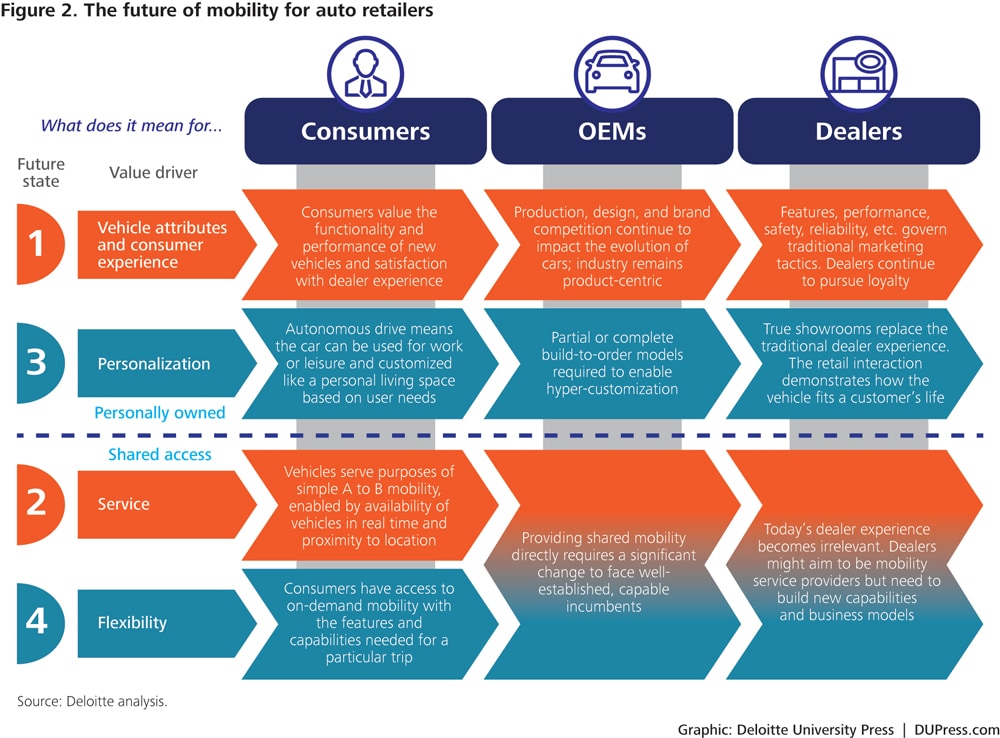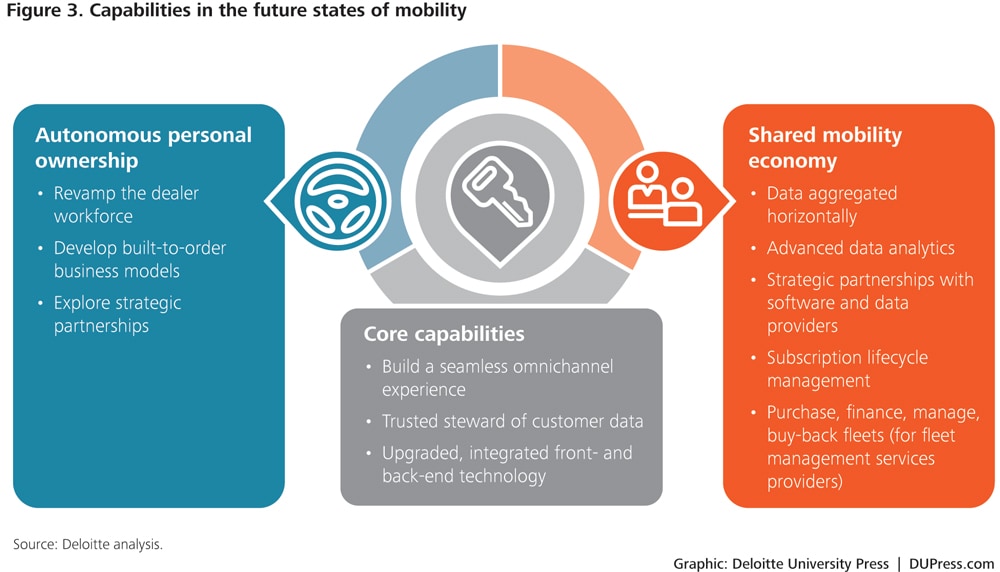The future of auto retailing has been saved

The future of auto retailing Preparing for the evolving mobility ecosystem
16 March 2016
How will tomorrow's car salesman sell customers on ridesharing and autonomous vehicles? As the future of mobility arrives, automakers and dealerships may need to rethink their traditional operations to appeal to customers looking for customization and connectedness.
Introduction
Remember the last time you bought a car?
Explore
Visit the Future of Mobility collection
Watch a video of Ben's journey
Listen to the podcast
Subscribe to receive updates on Future of Mobility
Explore Deloitte Review, issue 20
Hardly anyone finds today’s automotive retail experience—researching, contacting the dealership, test driving, financing, and closing the deal—efficient and satisfying.1 Indeed, just 17 out of 4,002 car shoppers in a recent survey—less than 1 percent—said they were happy with the well-established process of buying a car.2 Auto retailers have acknowledged this dissatisfaction and responded with incremental changes. As other industries become more customer-centric, however, creating a less painful retail experience is increasingly table stakes for carmakers and dealers.
While improving the process is laudable, and increasingly necessary to lure customers onto the lot, such steps are hardly sufficient given the fundamental transformative dynamics reshaping the automotive industry. As Deloitte’s article The future of mobility describes, the advent of autonomous drive and carsharing and ridesharing models (among other forces) are transforming how people move from point A to point B.3 Just as affected will be the automotive retail experience—how people consume mobility—and companies that start building capabilities today to succeed tomorrow will likely gain a significant advantage.
This sort of change demands a shift in mind-set beyond reducing the number of signatures required on dealership paperwork. This article highlights the immediate need to shift from a model focused on products (the vehicle) to one built on mobility experiences. Most importantly, it helps dealers and automotive original equipment manufacturers (OEMs) think about how to address several key questions:
- In a world of carsharing and autonomous vehicles, what experiences do consumers expect, and what are the manufacturer’s and retailer’s roles in the future ecosystem?
- What are the critical capabilities that today’s automotive retailers must develop to evolve their business for the long term?
- What concrete actions should OEMs and dealers take today to lay the foundation for the strategies of the future?
Experience trumps product—and auto retailers are falling behind
The retail landscape across industries is in flux, driven in large part by the change from product-focused to customer-centric value models. Empowered by technological advancements and public policy liberalization, consumers enjoy lower switching costs, greater access than ever to information, and higher standards,4 all posing challenges for companies operating with scale-based, efficiency-driven, product-centric models.5 Retailers are now seeing customers compare their buying experiences across industries, and the old adage “That’s how it’s always been done” is increasingly inadequate. And demographic trends will only exacerbate these developments: When it comes to making car purchase decisions, Generation Y drivers value customer experience three times as much as vehicle design.6 Retailers need to redouble their efforts to create memorable and painless customer experiences in order to retain today’s customers and appeal to new ones.
For many traditional retailers and OEMs, responding to growing consumer demand for a more satisfying car buying and servicing experience demands a significant reorientation. Car manufacturers have long been product-oriented companies, with large volumes of vehicles built to be stockpiled at dealer lots and commission-incentivized salespeople responsible for maximizing the bottom line. Forays into alternative models, such as build-to-order, have enjoyed limited success.7 Today’s customers increasingly insist that their retail interactions be tailored experiences, and they are more willing than ever to abandon retailers that fall short.8
Shifting focus to individual customer needs, prioritizing retention and relationship management throughout the retail interaction, and building an agile supply chain to anticipate and meet consumer demands are central imperatives today for manufacturers and retailers. While many are rising to the challenge, there’s a long road ahead. Indeed, our conversations with dealers suggest that many are proceeding with business as usual, having yet to fully grasp the changes underway (see sidebar, “What are dealers saying today?”).
What are dealers saying today?
Interviews with sales, finance, insurance, and service representatives at 17 highly rated American dealerships suggest that the industry has a long way to go when it comes to thinking about the future of automotive retail and the relevance of customer experience.9
- “Uber won’t impact [automotive retail and sales]; the cars still need to be sold.”
- “[The OEM] has tests and training for product knowledge but not around . . . strategies for the customer experience.”
- “[For salesperson performance metrics], they basically look at the results of sales.”
- “I think the self-driving thing is terrible; it makes me think that sales will also become automated and salespeople won’t be important.”
- “We get training on . . . how to close a customer and make the sale—that’s priority.”
Adding fuel to the fire: The future of personal mobility
The fundamental shifts under way in the mobility ecosystem pose a further challenge to automotive players—indeed, the changes threaten to undermine long-standing assumptions of personal car ownership on which today’s business models are built.10 In addition to responding to the rising demands of today’s consumers, OEMs and dealers need to prepare for even more transformative changes that will require a reimagining of what it means to be an auto retailer.
A series of forces are driving these shifts: alternative powertrain systems, advances in connected-car technologies, the application of new lightweight materials, consumer preferences for pay-per-use mobility, and the introduction of autonomous vehicles. Their convergence could propel a long-established system into a transformation yielding a new mobility ecosystem, one ultimately defined by two critical trends. First, and most critically for auto retailers, is the move from individual ownership toward shared access to mobility, in which the emphasis is on movement from point A to point B. Second is wide adoption of autonomous vehicles. Figure 1 shows the four future states of mobility emerging from these two developments.

Change will happen unevenly, with different populations in different geographies requiring different modes of transportation, which means that the four future states may well exist simultaneously. Each, however, carries with it a unique set of customer expectations and requirements that determine how value is created for both the consumer and the dealer (figure 2).11 Auto retailers have a “right to win” in states 1 and 3, where something approximating a conventional retail process—cars sold to individuals—endures. The same cannot be said of future states 2 and 4, where what is being consumed is end-to-end mobility and the basis of competition shifts from a capital asset sale to providing or managing a seamless and integrated mobility experience. This introduces a broader set of competitors that dealers will have to out-compete if they aim to remain relevant for a growing part of the personal passenger transportation business.

Personally owned vehicles
Future state 1. Incremental change
In future state 1, incremental change, customers continue to shop for vehicles based on traditional marketing and product characteristics, such as safety, comfort, fuel economy, technology, quality, reliability, durability, and brand. OEMs and dealers maintain their conventional roles. Consumer expectations will continue to evolve as people demand a more seamless and tailored car-buying experience, but the defining customer value driver in future state 1 will remain—as it is today—vehicle attributes and consumer experience.12
Future state 3. The driverless revolution
With full autonomous driving becoming more widely adopted and mainstream, the mobility experience changes in important ways. As the vehicle evolves from simply a transporter to a personally tailored platform for increased productivity and entertainment, the dominant customer value driver becomes the capability for customized configuration and personalization. Freed from the constraints imposed by human control, the cabin becomes a multipurpose living or office space during trips. Owners could design and decorate their vehicles the way they do family spaces, with unique physical configurations, entertainment options (including state-of-the-art, large-screen video and sound systems), finishes, and more. Mercedes has demonstrated the possibilities with its F015 electric concept car.13
Customers may increasingly expect OEMs to build vehicle platforms that increase the flexibility and range of choices for buyers to tailor the vehicle. With more vehicles powered by electricity, complexity is reduced and supply chains can become more agile and lean, enabling highly advanced build-to-order models.14 Dealers will need to provide much higher levels of product tailoring and customization advice and customer support, to the extent of being a co-creator of the final product. This will drive the transformation of auto dealers into product experience centers, showcasing models designed to enable easy customization. Many dealerships may come to resemble a more advanced form of Tesla’s store, combining online shopping with in-store guidance.15 The car buying experience could manifest itself as an extended “test live” period (rather than a test drive), during which a customer could gauge how the car improves daily life; a partially customized vehicle could take the form of a “base” configuration augmented with tailored entertainment and productivity software.
Alternatively, a more extensively personalized test vehicle could include an office on wheels, or a special configuration for long-distance travel, such as beds for an owner to rest on her way to the office or on a family vacation. Once a customer has decided to purchase, the retailer can use interactive digital features and potentially even virtual reality to help guide her through the myriad ways the vehicle can be customized for her needs.
Shared mobility
Future state 2. A world of carsharing
As we move from west to east in figure 1, the growth of carsharing and ridesharing will significantly affect a core function of today’s automotive retailing system: selling vehicles to individuals.
The shift toward this future state is already under way, with the expansion of carsharing and ridesharing services accelerating in the past few years. Services such as Zipcar have doubled their customer base in the last six years, while Uber has completed more than 1 billion rides globally as of the end of 2015.16 As passengers increasingly access end-to-end mobility on demand, the dominant consumer value driver shifts to service, with a key role played by end-to-end mobility service providers supplying and facilitating shared transportation.
Succeeding in shared mobility requires that retailers provide an integrated experience, one where the customer confirms pick-up and drop-off logistics with the touch of a button or via automated integration with their smartphone’s calendar. The user could evaluate the entirety of such an experience in real time, and payment for the ride and any add-ons would occur automatically, emphasizing the seamless and efficient nature of the shared model. Services would match drivers with riders according to user preferences, and carpooling models could even be integrated with social media, dating apps, and other digital networks.
Many OEMs are moving to become more significant players in carsharing and ridesharing. For example, Daimler’s Car2Go, BMW Drive Now, and Audi On Demand are offering short-term carsharing—but they face competition from established players, such as auto rental companies and today’s ridesharing and carsharing providers. If OEMs and large national dealers decide to enter this space in a much bigger way, they will have to substantially change their business models and build fundamentally different capabilities to do so successfully. This provides part of the rationale for why GM decided to invest in incumbent ridesharing company Lyft, rather than enter the market organically.17 Given the market’s increasing maturity, those not already in this space may risk being left behind.
Future state 4. A new age of accessible autonomy
The challenges for today’s auto retailers are likely to multiply as the convenience of shared mobility ultimately converges with the configurability of autonomous drive in future state 4. The dominant customer value driver becomes complete flexibility. Personalization remains critical to consumers, who would be able to customize a car’s tier and function in addition to its media content and productivity software, even as vehicles themselves become more utilitarian as users focus on functionality.
As in future state 2, an OEM or dealer could try to compete as a “trusted mobility adviser” or concierge, but successfully doing so would require an even more fundamental transformation of current capabilities and business models. Significant value creation will accrete to building the customer interface, with less value in manufacturing the physical asset or managing the fleet.18 For some, a more natural evolutionary role might lie in offering fleet management services to mobility providers—facilitating the purchase, finance, and maintenance of large numbers of autonomous, on-demand vehicles. Doing so would involve a shift from a consumer-facing to a business-to-business model, along with the ability to negotiate contracts, execute purchases, and arrange asset resale or disposal at the end of a fleet vehicle’s contract term.
This fully realized future of mobility entails all of the risks and challenges of future states 2 and 4. In this scenario, however, retail interaction is replaced with something more akin to a service-provider relationship or to that of today’s hotel concierge-customer interaction. A customer, from her smartphone, will order a car tailored to her needs: luxury for a special occasion, economy for the daily commute, a family van for a weekend trip. At the completion of a trip, the rider could simply “check out” of the vehicle, after which it might return on its own to a service center located at a yard at the edge of the city to be cleaned and fueled.
Preparing for the future of mobility
The future of mobility poses numerous challenges to automotive retailers. The emergence of autonomous vehicles and, in particular, the rise of shared access will force a rethinking of nearly every aspect of the car buying and ownership process; as more consumers migrate to shared mobility, it could make many established processes irrelevant for a large swath of the population. Even absent those trends, shifts in consumer expectations will compel auto retailers to focus more on relationships and experiences than on vehicle performance. OEMs and dealers need to undertake a clear-eyed assessment of their businesses to decide “where should they play” and “how should they win” in the future mobility ecosystem.19
Core capabilities
Some capabilities (figure 3) are essential for meeting the challenges of today’s auto retailing environment and in future state 1, while others will be valuable regardless of which future state of mobility a company ultimately seeks to participate in. To that end, companies should:
- Build a seamless omnichannel experience. The automotive retail customer experience model has remained relatively static for a long time. Too often, buying a car is characterized by opaque pricing and financing options, a time-consuming research and purchase process, and a one-size-fits-all approach to individual customers. But as with other areas of the retail space, our view is that omnichannel models that fully integrate digital and physical shopping experiences will increasingly become the norm in auto retailing.20
- With this in mind, OEMs and dealers should look to: engage consumers during the research phase with targeted, tailored digital advertising; leverage online capabilities, such as finance preapproval, to speed the car-buying transaction; and explore innovative store formats that create an immersive experience using, for example, interactive touchscreens. It is worth noting that some OEMs and dealers already do this to a limited extent, though automotive players need to better leverage the data they collect during the customer research phase, to help tailor customer experiences.
- Become trusted stewards of customer data. In all four future states, value will increasingly be a function of the ability to collect, aggregate, analyze, and act upon customer data. For instance, companies will look to use connected-car data to predict, mitigate, and prevent warranty and other maintenance or service issues.21 The extent to which manufacturers and retailers can successfully reposition themselves as either purveyors of bespoke vehicles (in a world of autonomous vehicles) or as mobility service providers (in a world of shared access) will hinge on their ability to seamlessly integrate data into every step of their operations.
- Doing so in a sustainable way requires that customers—the source of data—and companies both see sufficient value from the exchange to make it worthwhile.22 For auto retailers, that means building a level of trust with consumers that likely goes beyond what they have previously achieved. In a 2013 Harris poll of consumers’ views of industrywide reputation and trust, the automotive sector trailed telecom and technology companies, its obvious competitors for access to customer data.23 Closing that gap will require the ability to securely collect and store data—and the ability to convince consumers that they take security seriously. As important, customers will need to feel that the data they are relinquishing is being used to provide them with additional value in the form of a more tailored experience.
- Upgrade back-end and consumer-facing technology. As laid out in Deloitte’s paper The foundation of future automotive retail: Omnichannel customer engagement, the shift from product- to customer experience-based value means that OEMs and dealers will need to implement streamlined and customizable omnichannel models to remain competitive.24 To that end, OEMs and dealers should better integrate information between themselves, which can enable strategic campaign management, optimize marketing and media spend, and enable customers to define their own retail experience through connected digital and physical channels. Some firms have already made significant headway on this front. A Tesla Model S, for example, can be purchased entirely online, or an in-store associate can walk a consumer through the car features, ownership experience, and even the website itself on a showroom desktop.25 Going forward, stores will continue to morph to integrate digital and physical buying experiences.
Preparing for the driverless revolution
Widespread availability and adoption of autonomous vehicles will likely lag behind the spread of shared mobility. That said, dealers and OEMs have a “right to play” as long as vehicles remain personally owned; the necessary capabilities to achieve results in this future, as advanced as they may be, will not require the same type of foundational business model transformations as the move to shared mobility. This means that auto retailers can begin developing these areas almost immediately.
“Where to play” is largely foregone; the question becomes “how to win.” Successful retailers in future state 3 will need the ability to extensively and rapidly tailor vehicles. That requires companies to:
- Revamp the dealer workforce. For dealers, the unprecedented customization promised by self-driving vehicles will place greater demands on staff, who will need to be trained not only in the nuances of autonomous drive and other new technologies but also in how customers can personalize vehicles for their benefit utilizing their real-time personal and mobility data. Customer-facing employees should be equipped with a consumer’s needs, wants, and characteristics even before they first interact. Armed with digital tools, retail employees of the future should facilitate a smooth and painless end-to-end process, personalized by and for the individual customer.
- Develop build-to-order business models. OEMs, too, will need to consider how to meet the customization challenge. Companies are already pushing what is possible: Mini, for example, has made inroads into personalization with its “You-ification” optionality, allowing consumers to custom-order their vehicles with a number of accessory combinations.26 However, the OEM of the future will offer even deeper levels of customization, and the capabilities required to do so are diverse and extensive, ranging from the front-end platforms consumers use to design and order their vehicles to the reconfiguration of supply chains and production operating systems to be “even leaner, flexible, and ‘smart-customization’-enabled.”27 Customization should leverage the customer data, too—instead of inundating a customer with a flood of optionality, successful firms will use historical data on preferences and demographics to help streamline the customization process.28
- Explore strategic partnerships. To deliver a high-quality experience in an industry now full of unfamiliar technology and services, it is crucial that retailers leverage creative, strategic partnerships. Indeed, alliances across the mobility ecosystem are beginning to materialize already. For example, GM invested $500 million in ridesharing service Lyft, with the long-term goal of creating a fleet of autonomous shared vehicles.29 GM also acquired some assets of now-defunct mobility service provider Sidecar, with the goal of bolstering the expertise of its urban mobility team.30 Within the shared mobility space, Uber has partnered with Spotify to allow riders to play their own music in vehicles via the Uber app.31
In the context of a retail experience for autonomous but individually owned cars, an OEM in the future could consider a partnership with a firm at the forefront of virtual reality technology, allowing customers to “sit” in their customized vehicle before purchasing it. And the increased functionality offered by the vehicle’s cabin opens up the possibility of new or expanded relationships with a host of companies, from furniture makers to video equipment providers to home appliance vendors.
For both dealers and OEMs, the customizable experience at the center of future state 3 could require dynamic pricing options as flexible as a vehicle’s features. Companies could price cars by algorithms taking into account every customizable feature; alternatively, certain features could be leased while others are bought, perhaps with multiple warranties for various components of the car.
Preparing for a world of carsharing and a new age of accessible autonomy
The rise of shared mobility poses twin challenges to manufacturers and dealers. The first is urgency: Shared access to mobility, unlike autonomous vehicles, is becoming more commonplace and still has plenty of headroom for growth as new service capabilities are introduced and new geographic markets are entered. The second is that, as they currently operate, neither dealers nor OEMs have a “right to win” in future states 2 and 4. A host of established players have already staked out positions, and many auto retailers are ill-equipped to challenge them.
That means automotive companies should undertake a strategic assessment of where they want to play in the mobility ecosystem, well before they consider developing the capabilities discussed here.32 And these should be considered illustrative, not necessarily comprehensive—each company will need to assess its own abilities and limitations and respond accordingly.
After addressing the “where to play” question, companies will need to turn to “how to win.” Auto OEMs and dealers looking to thrive in a world of shared mobility should:
- Create horizontal data aggregation capabilities. Manufacturers and dealers already collect a significant amount of connected car, customer, vehicle, and service data, but much of it is in silos of different departments, including sales, marketing, and service, as well as in dealer management systems. Few companies effectively integrate this data into or across the retail process or the ownership journey. Collecting a tremendous breadth and depth of information about personal mobility could be a cornerstone for successful manufacturers and their dealers moving forward; the view of customers’ choices (how they shop, where they go, and how they get there) should be comprehensive. The value lies not in the data alone but, rather, in how that information makes services more valuable, reducing time and friction for both the end customer and the provider. OEMs who will become leaders in data aggregation will utilize platforms that not only collect data across siloes but also make the information more widely accessible for immediate use.
Some companies are well on their way: In late 2015, Audi announced plans to partner with Somerville, MA, applying swarm intelligence technologies to bolster automated parking algorithms in a new fleet of autonomous vehicles. Audi’s research indicates drivers looking for spaces generated as much as 30 percent of peak traffic,33 and the company plans to aggregate vehicle and traffic signal data to offer apps that optimize routes and reduce congestion.34 Over time, this kind of mobility data, originating from both vehicle movements and the broader mobility environment (traffic signals, parking lots, tunnels, roads, radar detection, and so on) could be mapped to detailed customer profiles to optimize routes, vehicles, and experiences for consumers and offered as either a paid service or as a competitive differentiator.
- Be ready to analyze—and act. If an OEM or dealer hopes to contend for the role of a trusted mobility adviser as described in Deloitte’s Navigating a shifting landscape, it must accompany the collection and aggregation of data with the ability to distill it and provide tailored insights for customers.35 This might take the form of a concierge-style service that proactively recommends the people, places, and companies that best suit a customer’s immediate and future needs. Such an analytics-driven concierge could inform product purchases, alert users to entertainment opportunities, and integrate with social networks and GPS information to recommend route options and parking along a route. This requires comprehensive real-time data analytics and an accessible and user-friendly customer-facing communication platform, neither of which are strengths of today’s auto players.
- Explore strategic partnerships. For those looking to serve as mobility service providers, partnerships can also be used to expand the pool of customer data available to retailers to tailor experiences—in particular, relationships with mobile device providers, social networks, app developers, location-based service providers, and network services that are already “seeking to position themselves as the integration points for an individual’s mobility profile” will be essential.36 As software becomes increasingly important in the extended automotive industry, identifying market trends and responding to them might require the assistance of firms more familiar with such models.37 Additionally, partnerships with hotels, restaurants, transportation providers, and other companies that allow for the sharing of customer data can enable more seamless and frictionless journeys from point A to point B.
- Be creative about making money. The revolutionary changes to operating models and value propositions merit a correspondingly fundamental rethinking of how firms make money. For revenue models based on shared mobility services, firms will need to develop significant infrastructure for subscription lifecycle management, including front-end systems governing payment, promotions, and billing that resonate with customers.
- Prepare for fleet management. In a world of shared mobility, regardless of whether vehicles are human-controlled or autonomous, fleet management services will play an important role. Much as they do today for corporate and shipping fleets, these companies will help purchase, finance, maintain, and buy back large numbers of vehicles for the providers of shared mobility. Some dealers have established positions in this space, with experience around business-to-business contract negotiations and purchasing, but it is highly competitive, and today’s fleet management companies have a strong competitive advantage against OEMs and dealers without fleet operations. Going forward, firms looking to manage fleets will need to expand capabilities around managing vehicle telematics, driver networks, safety features, preventative maintenance, and other features to allow a shared access service provider to more closely track and optimize the customer experience from pick-up to drop-off.
Our final suggestion is simple in theory but perhaps the most difficult in practice: Experiment relentlessly. The capabilities outlined above, necessary in due course, will likely take years to mature, and there is no fixed model for success. Incentivize innovation and risk-taking, and be prepared for setbacks. Invest in the infrastructure to support new thinking, including exploring new organizational structures or stand-alone innovation incubators.38 By fostering agility, failing fast, and capitalizing on ideas from within and without, OEMs and dealers will be better positioned to cope with the considerable challenges that the future of mobility presents.
Conclusion
The extended automotive industry is poised at the onramp of a massive transformation, driven by a series of converging forces. The most immediate and pressing challenge for automakers and dealers comes from the rise of pay-per-use transportation, which when mature could undermine a century-old business model built on selling cars to individuals and families. Over time, the proliferation of autonomous-drive vehicles could provide a more natural market space for automotive players, albeit one that rests on unprecedented customization.
Simultaneously, the industry faces a critical pivot from product-focused business models to more customer-centric ones. When it comes to delivering an optimal customer experience, OEMs and dealers are playing catch-up with disruptive players across retail. No longer do customers view their retail journeys in an industry-specific vacuum—they compare the quality of every buying and service experience relative to every other one, regardless of the product or service in question.
The new mobility ecosystem offers OEMs and dealers numerous opportunities and choices when it comes to deciding where to play. However, to survive the mobility transformation and thrive in tomorrow’s world, OEMs and dealers must begin to act soon. The advanced capabilities necessary for the future may seem far down the road, but the foundations upon which they will lie can—and must—be built today.
The Deloitte US Firms provide industry-leading consulting, tax, advisory and audit services to many of the world’s most admired brands, including 90 percent of the Fortune 500. Our people work across more than 20 industry sectors with one purpose: to deliver measurable, lasting results. Deloitte offers a suite of services to help clients tackle Future of Mobility-related challenges, including setting strategic direction, planning operating models, and implementing new operations and capabilities. Our wide array of expertise allows us to become a true partner throughout an organization’s comprehensive, multi-dimensional journey of transformation.
© 2021. See Terms of Use for more information.







